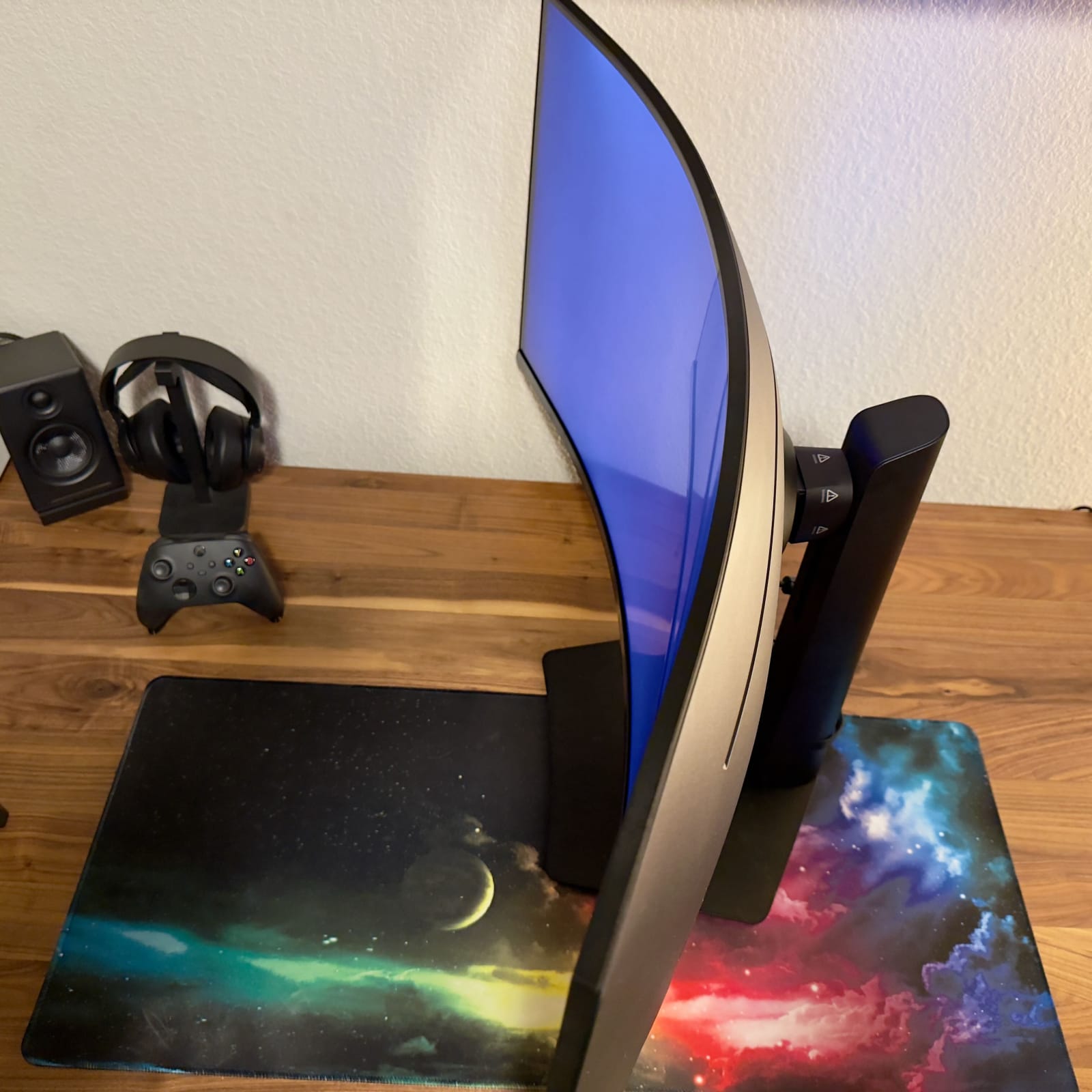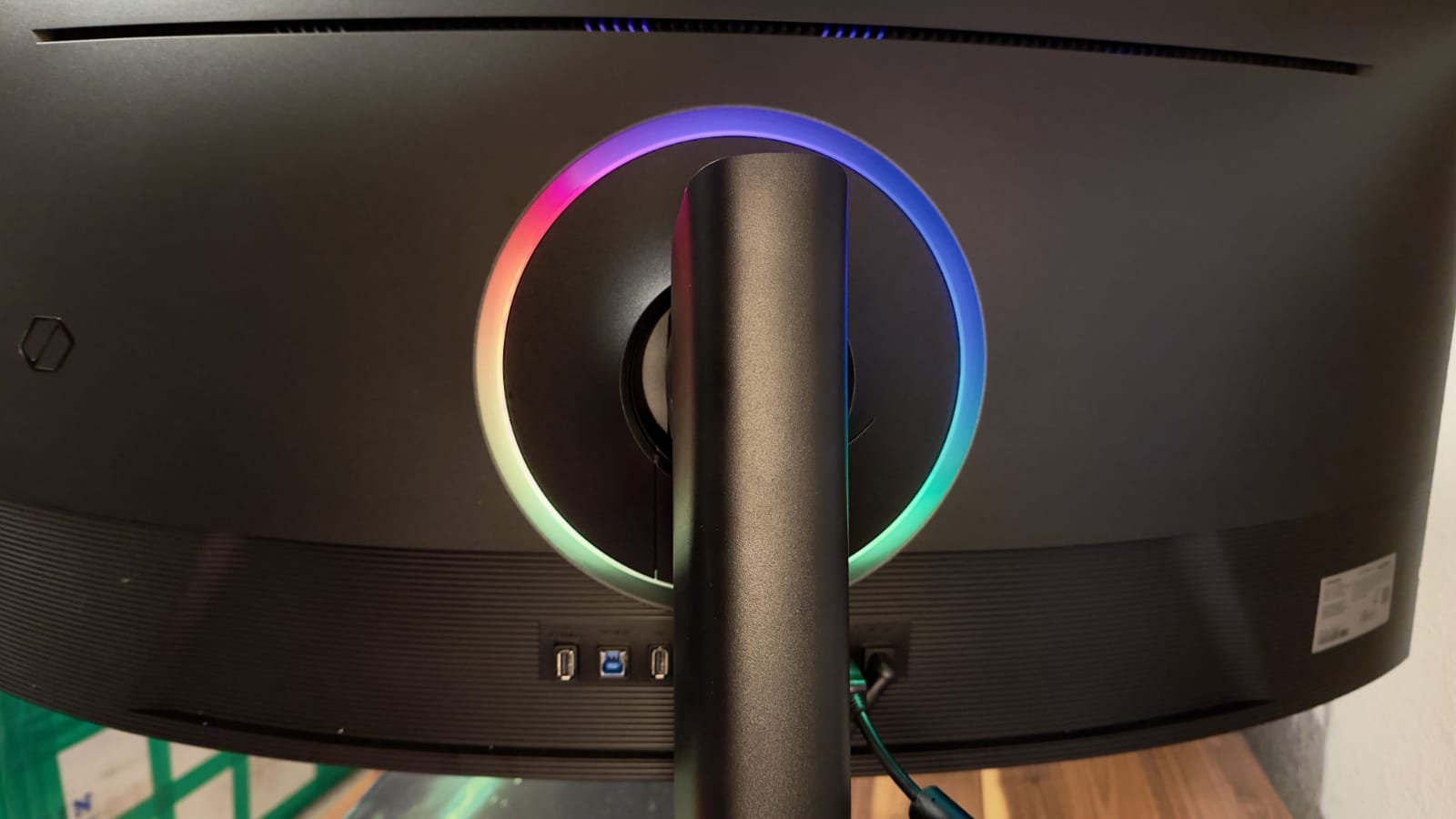
The first time that 1000R curve wraps around your peripheral vision at 180Hz, you'll understand why flat 16:9 monitors suddenly feel like looking through a window instead of being inside the game. Samsung's Odyssey G7 40" isn't trying to be everything to everyone; at $1,200 MSRP, it can't afford to be. But for sim racers craving cockpit immersion, power users consolidating multi-monitor setups, or gamers willing to sacrifice some competitive edge for jaw-dropping visuals, this ultrawide makes a compelling case that bigger, curved, and faster can coexist in one package. That ambition is apparent the moment you crack open the box.
Samsung's unboxing experience for the Odyssey G7 40" immediately sets a premium tone. The generous foam padding cradles the massive panel, eliminating any concerns about transit damage. This is an essential touch for such a high-value, large-format display. The assembly process is notably thoughtful: you secure the stand first before attaching it to the monitor while it remains safely face-down in its protective box. This methodical approach removes the awkwardness of balancing a 24.9-pound panel during setup, significantly reducing the risk of accidental damage or scratching.

Once lifted upright, the monitor's physical presence is undeniably imposing yet reassuringly solid. The stand exudes sturdiness, with a weighted base that anchors the 36.6-inch panel firmly without wobble. The heavy-duty construction (16.1 lbs without the stand) translates to zero flex or creaks when adjusting the tilt (-5° to 20°) or swivel (±20°), instilling confidence in long-term durability. While the sheer mass demands ample desk space, it also signals Samsung didn't compromise on materials or engineering. The inclusion of VESA wall-mount compatibility (100x100mm) offers flexibility for users who prioritize desk real estate over the stand's ergonomic perks.
The Odyssey G7 40" immediately impresses with its vibrant color reproduction and solid brightness right out of the box. Factory tuning delivers excellent sRGB coverage (99%) and strong DCI-P3 support (90%), making colors pop in both gaming content and media. The 350-nit typical brightness (with HDR600 capability) ensures decent clarity, though it's worth noting that VA panels can't peak as high as some OLED/QLED competitors. Where this panel truly excels is its native contrast ratio of 3000:1, resulting in deep, dark blacks that make dark scenes feel immersive, except when motion is involved.
Here's where VA technology reveals its classic trade-off: black bloom. When moving a bright element (like the cursor) across a dark screen, noticeable light leakage occurs. Vertical bands appear above and below the cursor in low-light conditions, flickering through light gray, then dark gray, then faded "black" before settling into true black. This isn't a defect but an inherent VA limitation due to slower pixel response times and liquid crystal behavior. While less severe than on cheaper VA panels, it's distracting in dim environments or dark games (navigating dark areas in Elden Ring, for example). At one point, I was rebooting and managed to capture a short video of the banding on the dark screen. Since it was a low-light capture, my camera's aperture was fairly wide open, so it's more apparent on video than in person.
Black bloom on a Windows restart screen.
HDR performance on the Odyssey G7 40" is competent but not transformative. Enabling HDR10+ Gaming in supported titles delivers a noticeable uplift over SDR. Highlights pop a bit more and shadow detail improves, but don't expect the jaw-dropping contrast swings of an OLED panel. The 350-nit brightness ceiling is the limiting factor here; while DisplayHDR 600 certification suggests peak brightness capability, the typical output keeps HDR from reaching that "wow" territory where sunlight or explosions feel genuinely blinding. Tone mapping handled itself well without blown-out highlights or crushed blacks, making HDR a nice-to-have rather than a system-seller. If you're upgrading from a non-HDR display, you'll appreciate the added dimension. If you're chasing OLED-tier HDR, this won't scratch that itch.
The 1000R curvature strikes a fine balance. Tighter than the more common 1800R or 1900R curves found on most ultrawides, it enhances peripheral immersion in games and movies by wrapping the display closer to your field of view. However, it's aggressive enough that extreme edge distortion can occur when viewing very bright objects at screen corners, making it less ideal for productivity tasks requiring straight lines. For gaming, the curve excels: racing and flight sims feel more enveloping, and competitive shooters benefit from a tighter "focus zone" at the center. The key takeaway? This curvature prioritizes gaming immersion over versatility, ideal for dedicated gamers but potentially distracting for hybrid use.

The Odyssey G7 40" delivers an exceptional gaming experience that bridges the gap between raw speed and visual fidelity. The 180Hz refresh rate immediately feels smoother than standard 144Hz panels, creating fluid motion in fast-paced titles like Cyberpunk 2077 or Helldivers 2. What makes this speed impressive is the resolution backing it: at 5120 x 2160, the 139 PPI delivers razor-sharp detail that makes textures and UI elements crisp even at close viewing distances. Combined with the 1ms response time, there's zero perceptible ghosting, even in high-action sequences with rapid camera pans or explosions. Input lag is imperceptible. Actions translate to screen instantly without the disconnect felt on slower panels. Crucially, the FreeSync Premium Pro certification eliminates tearing entirely, ensuring buttery gameplay without screen-tearing artifacts or stuttering. The only caveat? At 180Hz, demanding AAA titles will require a high-end GPU to consistently push 5K frames—a trade-off for uncompromising visuals.
While clearly a gaming powerhouse, the Odyssey G7 40" impresses as a productivity tool. That same high pixel density translates to near-printer-sharp text clarity, which is great for document work, coding, or detailed design tasks. The 21:9 ultrawide aspect ratio unlocks exceptional multitasking potential: side-by-side windows, code editors with terminal previews, or multi-tab research setups feel fluid and expansive. This real estate reduces window-juggling in ways a standard 16:9 monitor simply can't match.
The stand's ergonomics are a standout for a panel of this size. Height adjustment (HAS), ±20° swivel, and -5° to 20° tilt provide near-total flexibility for seated or standing postures. While the sheer width (36.6") demands a deep desk, the sturdy base prevents wobble even during aggressive typing or mouse work.

Productivity Caveats: The curve that enhances gaming immersion introduces mild edge distortion when viewing straight text documents or spreadsheets at full screen. While the color gamut coverage is strong, VA panels suffer from color shifting at angles, which is a dealbreaker for professional photo or video editing where color accuracy across the screen is critical. The brightness may also feel underwhelming in sunlit rooms. Still, for hybrid users needing one monitor to handle both gaming and productivity, the G7's blend of sharpness and real estate is hard to beat.
Samsung's software suite on the Odyssey G7 40" impressively avoids overshadowing its core strengths. Features like Core Sync (RGB lighting synchronization) and Auto Source Switch+ (input detection) operate as unobtrusive background tools that simply work without manual configuration. Picture-in-Picture (PiP) and Picture-by-Picture (PbP) features are logically tucked into menus, letting you scale secondary sources to the corner or divide the screen for dual inputs. These are useful for streamers or data-heavy workflows, though I didn't use them regularly. The absence of bugs, hidden menus, or forced setup steps speaks to polished firmware engineering. One notable omission: there are no built-in speakers, so budget for external audio or plan to use the 3.5mm headphone jack exclusively.

The Odyssey G7 40" is a niche powerhouse, not an all-rounder. At full MSRP, it demands justification, but for the right user the ROI is clear.
This monitor finds its perfect home with racing sim enthusiasts and flight simulator pilots, where the 1000R curve combined with WUHD resolution creates a true "cockpit dome" experience. Trackside details and instrument panels feel immersive without fisheye distortion, outpacing even ultrawide flat screens. Single-monitor power users will also appreciate the consolidation. If you prioritize one display for everything (gaming, media, and productivity), the G7's 5K2K resolution and 40-inch real estate reduce clutter. Paired with a powerful GPU, it handles AAA titles in HDR and 4K video editing, though VA's color limitations may frustrate professional creatives.

At $750 at the time of this writing, this becomes a deal that's hard to pass up. The combination of 180Hz, HDR600, and 3000:1 native contrast rarely appears together under $1,000.
However, competitive FPS players should look elsewhere. The 40-inch size forces head movement to spot edge-of-screen HUDs like minimaps and health bars. For esports, a 24- to 27-inch 1440p panel will offer faster reflexes and zero peripheral distortion. Budget-constrained buyers focused purely on gaming can also find better value in a 1440p 240Hz IPS monitor, which delivers similar motion clarity at half the price.
The $1,200 MSRP premium buys three key advantages over cheaper alternatives: unmatched immersion through size and curve, competitive-grade motion clarity at extreme resolution, and professional-grade color coverage (90% DCI-P3). However, VA's black bloom and brightness ceiling hold it back from OLED-tier excellence. If you can stomach those trade-offs and the price aligns with your budget, this is a definitive buy for sim and media enthusiasts.
Samsung's Odyssey G7 40" is a statement piece: bold in size, ambitious in specs, and uncompromising for its target audience. For sim racers, movie buffs, or gamers wanting one screen to rule them all, it's a transformative experience. At full price? Situational. On sale? Irresistible for the right person.
Samsung Odyssey G7 Gaming Monitor
Excellent
The $1,200 MSRP premium buys three key advantages over cheaper alternatives: unmatched immersion through size and curve, competitive-grade motion clarity at extreme resolution, and professional-grade color coverage (90% DCI-P3). However, VA's black bloom and brightness ceiling hold it back from OLED-tier excellence. If you can stomach those trade-offs and the price aligns with your budget, this is a definitive buy for sim and media enthusiasts.
Samsung's Odyssey G7 40" is a statement piece: bold in size, ambitious in specs, and uncompromising for its target audience. For sim racers, movie buffs, or gamers wanting one screen to rule them all, it's a transformative experience. At full price? Situational. On sale? Irresistible for the right person.
Pros
- Exceptional gaming immersion
- Outstanding motion clarity
- Versatile productivity powerhouse
Cons
- VA black bloom
- Limited HDR impact
This review is based on a retail unit provided by the publisher.
